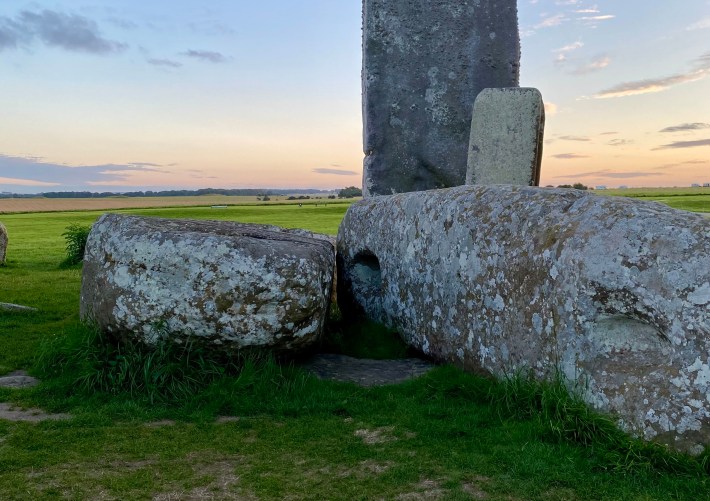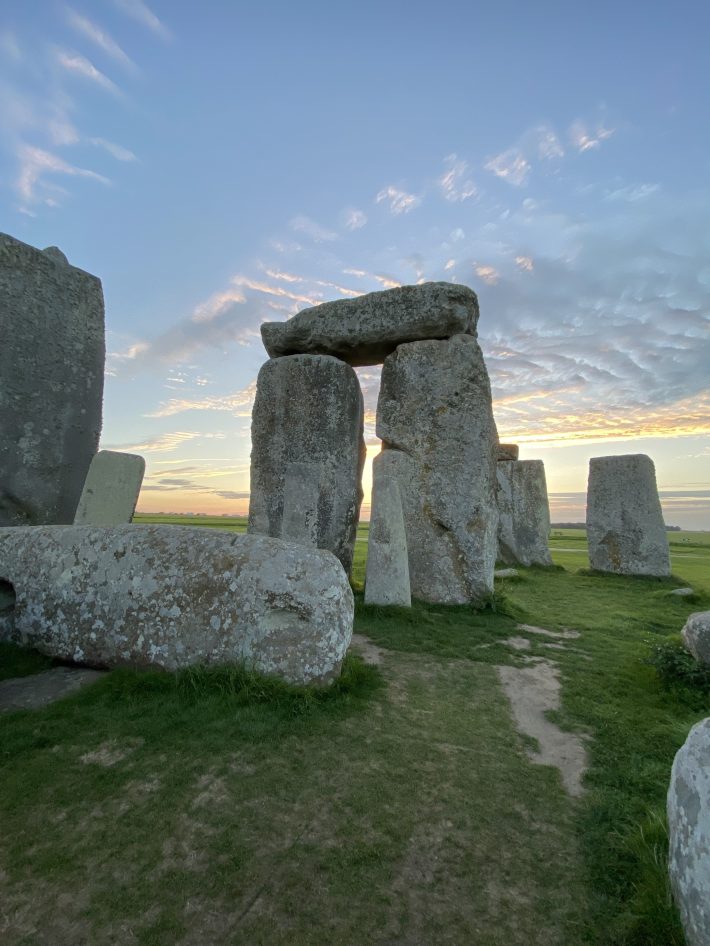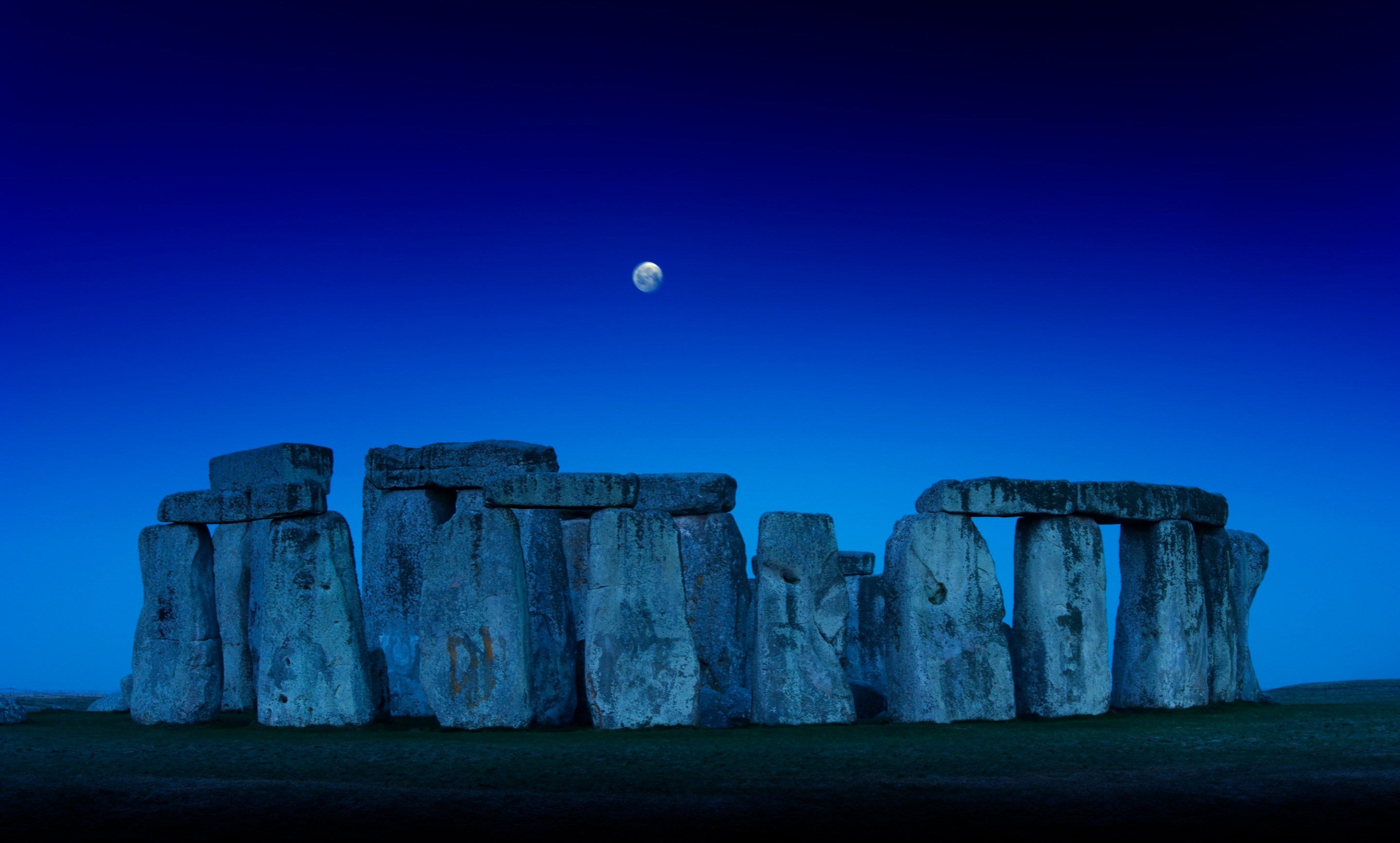Most people who visit Stonehenge come to admire the site's most obvious stones: the enormous, upright sarsen blocks that form the columns of the circle, as well as the scattered bluestones that take on a bluish tinge after rain. But one of the strangest bluestones, which rests at the heart of the clustered monument, has a different appearance and origin. This six-ton slab of red sandstone called the Altar Stone rests flat on the ground, nearly obscured by fallen pillars which collapsed on the sandstone long ago. "The Altar Stone could be missed by most people today," said Amanda Chadburn, a visiting fellow at Bournemouth University and trustee at World Heritage UK. But for the discerning visitor, the stone peeks out, resolutely greyed purple and darker than the stones atop it.
The Altar Stone got its name in 1620 from Inigo Jones, court architect to King James I, who surveyed, measured, and drew the monument. Stonehenge contains two concentric arrangements of stones. The inner horseshoe contained five trilithons: two vertical stones capped by a horizontal lintel stone, which slotted into each other. Two of the trilithons have partially fallen, and the Altar Stone was placed in an important position just in front of one of the tallest trilithons, "which is arguably the focus of the monument, and through which the setting sun can be viewed at midwinter," Chadburn said.
Stonehenge was constructed over approximately 1,500 years, with the first large stones raised around 2500 B.C.E. In recent years, researchers have traced the origins of various stones to a smattering of places, some many miles away from Stonehenge. Archaeologists suspected and later confirmed that the large sarsen stones, each of which weighs about 25 tons, were quarried from the Marlborough Downs area around 20 miles away. In 2015, researchers confirmed the smaller bluestones came from a site 180 miles away in southwest Wales—perhaps an even more impressive feat of transportation for the Neolithic people who built Stonehenge. The Altar Stone was believed to come from south Wales until researchers debunked the theory in 2023.

Now, scientists have discovered the Altar Stone actually hails all the way from northeast Scotland, which entailed lugging the 12,000-pound, 16-foot hunk of rock at least 465 miles by land, or by an even longer route at sea. It is the stone that appears to have traveled the furthest to arrive at Stonehenge, and its journey occurred before the invention of the wheel. "I was delighted and excited by the discovery but truthfully not that surprised," said Chadburn, who was not involved with the new paper. She noted that a famous polished macehead found at Stonehenge was made of a metamorphic rock called gneiss, which almost certainly came from the the Isle of Lewis in Scotland. This showed "a link of some sort with Scotland during the early phase of the monument," she added.
The authors of the new paper, who are based in Australia, Wales, and England, traced the Altar Stone by studying the age and chemical fingerprint of its fragments. Specifically, they analyzed grains of zircon, apatite, and rutile that contained uranium, which allowed them to determine the stone's age via radiometric dating. "Given its Scottish origins, the findings raise fascinating questions, considering the technological constraints of the Neolithic era, as to how such a massive stone was transported over vast distances around 2600 BC," Anthony Clarke, a graduate student at Curtin University in Perth, Australia, and an author on the new paper, said in a statement.

It certainly is a fascinating question: How on Earth could prehistoric people move this massive rock nearly 500 miles, especially without the wheel? The seeming improbability of such a journey has led one researcher to suggest that the other bluestones of Stonehenge were not transported by prehistoric people, but rather deposited by a glacier, which slid them over from western Wales and dropped them off in the field. Archaeologists overwhelmingly disagree with this hypothesis.
Could the Altar Stone have been a glacial erratic? For some, the new paper raised this old question again, but the authors of the new paper squash this theory as geologically impossible. The glaciers of northeast Scotland moved northward in the last two ages, and there is little evidence of Scottish erratics around Stonehenge. Chadburn says she, too, is wholly convinced, noting the sarsen stones came from 25 miles away. "These can only have been transported by people, I see no reason why a much smaller stone could not have been transported by people too," she said. In the eyes of Mike Pitts, the author of How To Build Stonehenge, the persistence of the glacier theory betrays a certain modern superiority complex. "Even if it was possible, why this unwillingness to credit Neolithic people with skills or imagination?" Pitts tweeted.
The more fascinating and eternal question is, perhaps, not how, but why people would have gone to such an effort to build Stonehenge, or any of the hundreds of Neolithic stone circles constructed in the British Isles. This question has persisted for centuries: When the prolific English diarist Samuel Pepys visited Stonehenge in 1668, he wrote of the stones, "Came thither, and find them as prodigious as any tales I ever heard of them, and worth going this journey to see. God knows what their use was."
Although Stonehenge was erected around the same time as the Sphinx and the Great Pyramid of Giza, much less is known about the British monument. "My best guess is that Stonehenge was some sort of religious-funerary monument, or temple if you like," said Chadburn, who recently published a book with Clive Ruggles called Stonehenge: Sighting the Sun, which explores the site's relationship to the sky and early astronomy. Stonehenge was designed to align with the sun on the solstices, and was clearly one of the most important monuments of its time to the people who built and visited it, Chadburn said.

The Altar Stone remains a particular enigma, as researchers do not know if the stone was originally placed standing or recumbent, or when exactly it arrived on site. The authors of the new paper argue that people would likely have transported it by sea rather than navigate a rugged land route. Conversely, Pitts argues for a land route, highlighting the dangers of losing such precious cargo on a boat. And a land route would also have engaged many villages along the way, some of which boasted henges of their own. "Stonehenge was not just a great ceremonial or religious monument, but also a social construction: it was designed to impress and to bring distant communities together, so that transport and building were key parts of its purpose and identity," Pitts wrote on his personal blog.
However the Altar Stone was carried to rest at the heart of Stonehenge, it strengthens the links between Neolithic societies across the British Isles. Stonehenge was not just a geological collaboration, but a human one. "It seems that it may have meant something to many people throughout the island of Britain, given that the building materials seem to have been sourced from a number of places on the island," Chadburn said. "What it meant, exactly, is very difficult to unpick."






